Chapter One—
Conflicting Ideas about Hotel Life
People live in hotels, full-time, throughout the United States. Americans have done so for over two hundred years, often choosing hotel life over other housing options. Hotel rooms have provided indispensable housing units, sheltered important social groups, supported essential industries and businesses, and represented cosmopolitan diversity in American society. Hotel homes have also revealed deep conflicts in urban life, helped industrialists exploit workers, generated fortunes in downtown real estate, and challenged the dominant cultural values of how homes should shape American culture.
Most American hotels are now run exclusively for either tourist use or residential use. Until about 1960, however, a majority of hotel keepers not only offered travelers rooms for the night but also provided rooms or suites for permanent residents who rented by the month. Although residential hotels have moved into the shadows, they still provide a significant share of America's urban homes. In 1990, hotel residents numbered between one million and two million people. More people lived in hotels than in all of America's public housing.[1]
In 1980, San Francisco's permanent hotel residents numbered three times the population in the city's public housing projects. Permanent residents occupied over half of the city's 51,000 hotel rooms, and those
27,000 hotel homes comprised 10 percent of the city's total housing units. Other cities have reported similarly significant figures. In New York in 1986, the largest study of inexpensive hotel homes ever undertaken by an American city found that 87,000 New Yorkers lived in hotels. Citizens in small towns and small cities also rely on hotel housing; for example, planners estimate that one-third of California's residential hotel rooms are in cities with populations under 50,000.[2]
Hotel Homes and Cosmopolitan Diversity
Commercialized hotel life and private household life occupy different positions in regard to several cultural issues: the proper type of household, who should cook the food, how close Americans should live to their neighbors, who (if anyone) should have control and surveillance over an individual's activities, how mixed the land uses adjacent to American homes should be, and how committed Americans should be to private material possessions. These issues cut through all of the several types of hotel life.
Defining the Wide Range of Hotel Life
The diversity of hotel life stems from the diversity of hotel residents, the relative stability of their work, and their income. Recent hotel residents have included people like San Francisco's Cyril Magnin, the wealthy owner of a chain of clothing stores, three-time president of the Chamber of Commerce, and San Francisco's chief of protocol for over twenty years. From 1960 until his death in 1988, Magnin lived in a multiroom suite that occupied the fifteenth floor of a city landmark, the Mark Hopkins Hotel.[3] In Washington, D.C., Lawrence Spivak, longtime moderator of NBC's "Meet the Press," has lived for over thirty years in the Wardman Tower of the Sheraton Washington complex, a large hotel in a single-family neighborhood near Rock Creek Park. Spivak's hotel neighbors have included Dwight Eisenhower, Lyndon Johnson, Perle Mesta, Clare Booth Luce, and Herbert Hoover (who also maintained a hotel suite in the Astor Towers of New York's Waldorf-Astoria).[4]
Prestigious addresses, time saved in traveling to work, snob appeal, spectacular views, and having unctuous service without supervising servants are conveniences that keep busy and wealthy residents at exclusive hotels. All this has led Paul Goldberger, the architecture critic
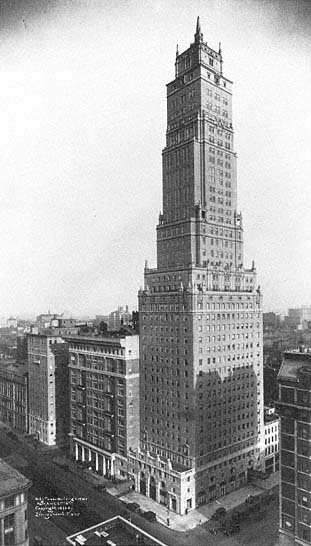
Figure 1.1
The Ritz Tower in New York City in 1926, one year after its
completion. The Ritz has long been a favorite for permanent
guests.
for the New York Times , to write that "the perfect apartment, at least in New York, is probably in a residential hotel" (fig. 1.1).[5] In an expensive hotel, permanent residents usually rent two to seven large rooms, including a kitchen, and in many ways live as they would in an apartment.[6]
Only a tiny fraction of hotel life is so elegant. Dorothy Johnson, a sprightly sixty-five-year-old widow, lives in a single room in a Minneapolis hotel. Like a great number of middle-income people who rent one or two rooms in a decent hotel on a good street, she cooks simple meals on a hot plate in her room and enjoys daily room service, a mod-
erately priced dining room, and several cheap coffee shops close by. "I've sold my car because everything is within walking distance," Dorothy says. "My friends in the hotel and I can look forward to an outing arranged by the staff, or on the spur of the moment we can go shopping, take in a movie, or see a play—all without driving."[7] A significant notch lower on the price scale was the hotel living experience of play-wright Jane Wagner. In 1958, she moved to New York City as a young woman "absolutely alone," as she puts it. For three years Wagner lived in a room at the YWCA. For her it was "the college dormitory she had never stayed in." Wagner's experience is hardly unique. In terms of the number of rooms rented in the 1980s, the YMCAs and YWCAs were the third-largest hotel chain in the world.[8]
As residential hotel prices edge toward the lowest range, the streets and neighborhoods are less safe and less desirable, but the locations are still central. In 1982, a veterans' center poster in San Francisco advertised such a hotel like this:
Rooms for rent. Family atmosphere; clean, freshly painted rooms. Community kitchens; clean sheets once a week. Close to the subway. Only $195.00/month rent.
The advertised building is old; built in 1906, it has forty-nine rooms. The bathrooms are down the hall.[9] In hotels of this price range it is not uncommon to look into a room and see a group of friends and four plates on the bed: a dinner party for four, the host cooking (almost legally) on a camp stove, his spice and pot racks on shelves above. Plants crowd some rooms; books, a television set, and cast-off easy chairs crowd others. On occasion a pet kitten scampers down the hall (fig. 1.2).[10] In 1977, Felix Ayson, a Filipino field worker, explained to reporters that he had lived in such a hotel in San Francisco on and off from 1926 to 1977. "Whenever there was no work in the country, I have come to find a job in the city, and I have lived here. Most of the time in America I have spent in this hotel, so it is my home."[11]
Although their homes are very different, Cyril Magnin, Dorothy Johnson, Jane Wagner, and Felix Ayson all have enjoyed what the law defines as a hotel. Legally, a hotel provides multiunit commercial housing, usually without a private kitchen. More precise definitions are complicated since local ordinances, state statutes, and federal programs
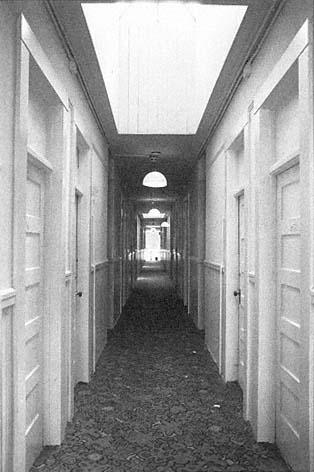
Figure 1.2
A hallway in San Francisco's National Hotel, a large
inexpensive residential hotel which mixes permanent
and transient guests.
set different criteria. Most state codes define a hotel as a commercial operation renting sleeping rooms by the day, week, or month. California's legal definition of 1917, still in force, stipulates that a hotel is "any house or building, or portion thereof, containing six or more guest rooms which are let or hired out to be occupied or are occupied by six or more guests."[12] Depending on the state, the minimum number of rooms in a hotel can vary from three to thirty. Hotel definitions exclude group quarters such as hospitals, jails, and military barracks.
The definition of permanent residence in a hotel (as opposed to being a transient guest) has to do with the length of time one stays. In most states, if a tenant lives in a hotel room for more than a month, that room is then a residential hotel unit, and the person is legally considered a permanent resident of the city. The one-month residency often
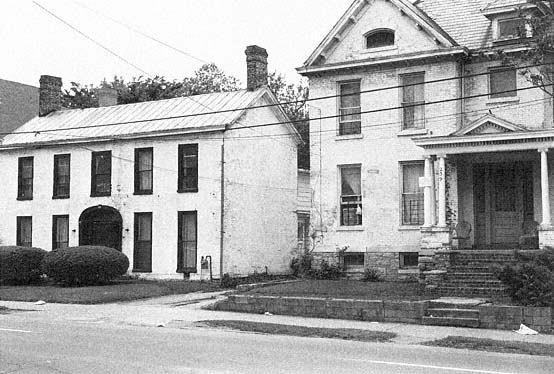
Figure 1.3
Two nineteenth-century houses converted to rooming houses, photographed in 1985. In most states
these Lexington, Kentucky, structures would legally qualify as hotels.
applies to apartment dwellers as well and has been a typical residence requirement since the time of the Civil War.[13]
The phrase "boardinghouse reach" comes from an important variant of hotel life. In boardinghouses , tenants rent rooms and the proprietor provides family-style breakfasts and evening dinners in a common dining room. Traditionally, the food was put on the table, and everyone scrambled for the best dishes. Those with a long, fast reach ate best. The term "residential hotel" includes other variations. In private rooming houses (called private lodging houses in some cities), tenants simply rent a room and buy their meals elsewhere. If tenants eat their meals with the family, they are called boarders; if tenants eat elsewhere, they are called roomers or lodgers.[14] If a family rents out many rooms (more than six in California), their boardinghouse crosses over into the definition of a commercial hotel. Commercial boardinghouses and lodging houses are technically open to taxation and inspection as hotels (fig. 1.3).[15] Residential motels, particularly common in resort areas and along bypassed highway routes, operate under the same legal definitions as residential hotels.
The absence of a private kitchen separates hotels from apartments. By 1900, lawyers used the cooking area and the presence of a private bathroom for each unit to distinguish the more socially proper apartment from the less proper tenement. The terms usually stipulate that "families living independently of one another and doing their own cooking" in buildings for three or more households are living in apartments and not in hotels.[16]
Cultural Challenges of Hotel Life
People living in hotels of all types create and support alternatives to traditional household culture.[17] Foremost traits among the distinctions of hotel life are unsupervised individual independence, cosmopolitan mixture, and a life unfettered by place and possessions.
Hotel life offers more individual freedom than any other housing option. Residents in 1870, 1920, and 1980 have all appreciated this characteristic. Without telling anyone in advance, they can dine one night at 8:00 and the next at 5:00 and yet inconvenience no one. In hotels, people on unusual schedules can sleep when tired, awaken when refreshed, eat when hungry, and drink when thirsty.[18] Those few services not available in the hotel can be found within walking distance. Hotel freedoms, however, have never been complete. As in most apartment houses, complete acoustical privacy can be difficult to obtain. One's comings and goings are less controlled than in a family house, but hotel desk clerks take careful note of everyone who passes.[19] However, hotel clerks rarely question the personal life of any guest whose bills are paid and who is not annoying neighbors. In short, hotel life can be virtually untouched by the social contracts and tacit supervision of life found in a family house or apartment unit shared with a group.
Another general ingredient of downtown hotel life is neighborhood mixture—a composite of retail and office activities, production and consumption spheres, many types of recreation, and people who are rich and poor, famous and infamous, married and single, young and old, transient and resident.[20] The term "cosmopolitan" certainly fits these juxtapositions. Active hotel people can feed on the 24-hour stimulation and spontaneity that their choice of residence offers. "You know," one happy hotel dweller affirmed, "I just love to be where there's life and city lights."[21] Downtown hotel life has the promise to be not just urban but urbane.
In another major departure from the typical household culture of the United States, residents of hotels keep themselves freer of material possessions than their suburban counterparts. The absence of household property makes hotel people more obviously mobile than other Americans who move often. Most hotel residents share typical American values, but they do not (or cannot afford to) fasten their identities to the anchor of private property. Even for wealthy hotel residents, a month or a season's lease is the longest financial commitment and tie to their home. They rent their furniture, dishes, and all other aspects of shelter.
Underlying the personal freedom, mixture, and unfettered nature of hotel life is the reality that hotels are blatantly commercial, not in a realm separate from business or manufacturing. Nor has hotel life, especially at the cheaper levels, always been chosen. Within the logic of industrial capitalism—particularly as it matured about the turn of the twentieth century—some employers have relied on a large force of temporary and marginally paid workers. Hotel living helps to make this labor force viable (fig. 1.4). Yet hotels are not always housing of last resort. Studies consistently show that many Americans prefer hotel life over other available and affordable options. Some residents cling to hotel life rather than live with relatives, share an apartment, or (for the elderly) live in a nursing home.[22] Because of public policy and new economic forces, this preference is in a precarious position.
Barriers to Understanding Hotel Living
For over twenty years, the supply of residential hotel rooms has not met demand. In about 1970, reporters began to write about a situation they called the "SRO crisis," which highlights long-standing themes in the history of hotels. For city planners and housing experts, "SRO" does not mean standing room only. It means single room occupancy and refers either to an entire hotel or to a room within such a hotel. SROs are the most inexpensive types of residential hotels. They are almost entirely residential, offering few, if any, tourist rooms. For social workers, the term "SRO" means single room occupants—not the buildings but the residents.[23] If the rebuilding of our cities continues in its current path, the acronym SRO may indeed soon mean "standing room only." As the supply of residential hotel rooms rapidly dwindles, former hotel residents join the homeless on American streets and in city shelters. In
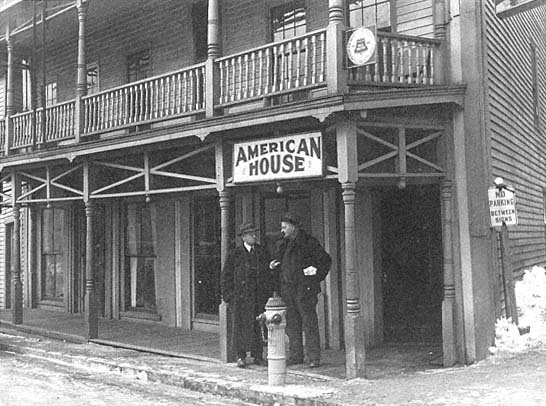
Figure 1.4
World War II shipyard workers photographed outside their hotel in Bath, Maine, 1940.
part, the present crisis results from misconceptions about who currently lives in hotels and has its roots in a cultural amnesia about this alternative downtown housing style.
The SRO Crisis as a Subset of Today's Hotel Life
SRO hotels are a subset of hotel life but its most important subset, both historically and in the present. Inexpensive hotels have pushed the traditional patterns of hotel life to social and practical limits. Statistics from most cities show that since World War II the United States has been losing affordable hotel homes at staggering rates and not replacing them. Downtown hotel owners, to improve their income or to eliminate management problems, have converted SROs to tourist rooms or other uses, torn the buildings down and built office towers, or simply closed the buildings. Between 1975 and 1980, San Francisco landowners eliminated 6,085 units, almost a fifth of the city's entire stock of residential hotel units. Chicago lost almost 23,000 units between 1973 and 1984.[24] A typical public housing project has about 250 units; thus, Chicago's
loss—in units—is equivalent to the loss of 92 housing projects. Some observers see these losses as positive developments—the removal of substandard housing and unwanted neighbors. To others, this wholesale closing and destruction of residential hotels is a major tragedy and a root cause of homelessness in the United States. These opposing views are not new; they have existed at least since the 1860s. Essential resource or public nuisance? How can one housing type be called both for more than one hundred years? How can the question remain open when the homes of as many as two million Americans depend on the outcome?
The lives of SRO residents inextricably intertwine with downtown hotel buildings; some residents literally cannot exist without them. Few, if any, housing alternatives for these residents exist. When owners close a building, tenants are lucky if they can find a worse hotel at higher rents. As the hotel stock dwindles, the option of moving evaporates, and tenants move to the streets. The street option has become increasingly evident in the numbers of America's homeless and street people. Even officials who dislike hotel life become alarmed as they realize that the closing of a 100-room hotel means that perhaps 150 more people may be living on the streets.[25]
In part because of the SRO crisis, myths about today's hotel residents abound. Hotel people are supposedly all friendless, isolated, needy, and disabled; all elderly; all on welfare; all elderly men; or all welfare mothers with three young children. All are presumably socially marginal, all mildly psychotic, all alcoholics or drug addicts, all drifters and transients who never live anywhere more than a few months; they are thought to be people whose homes cost taxpayers millions of dollars because of political corruption and bureaucratic waste. In spite of residents like Cyril Magnin and Dorothy Johnson, the most pervasive misconception about today's hotel residents is that they are all poor.[26] Journalists have made "welfare hotel" a synonym for all hotel life. In New York and other American cities, inexpensive hotels have become, in Jonathan Kozol's phrase, refugee camps for the American poor.[27] Each of these characteristics is sadly true of conditions in particular SRO buildings. However, not all SROs and certainly not all residential hotels with higher rents reflect such conditions.
Several recent studies dispel the stereotypes. For instance, fewer hotel tenants live on welfare than newspaper headlines suggest. Workers liv-
ing in hotels are still important to the urban economy. The authors of a San Diego study found that over half of the residents (and often more) were "independent, self-reliant individuals who were not dependent on public or private social services, nor had they been in the past." The older tenants often had fixed incomes, and the average tenure at the longest-held job was about twenty-one years. At the cheapest price range, a 1985 study of the SRO residents in Chicago found "a small prosperous minority, a majority barely earning enough to make ends meet, and a large minority of impoverished workers."[28] Where racial and ethnic minorities have low incomes, there hotels are also typically an important housing resource. In New York, a third of all SRO residents are black; a quarter are Hispanic. In San Francisco and Los Angeles, newly arrived families from Southeast Asia make up an increasing proportion of hotel residents. In San Francisco's Clayton Hotel, half of the residents are retired Filipino or Chinese laborers who, like Felix Ayson, have lived in one hotel seasonally for twenty to forty years.[29]
Not all single room occupants are single people. In New York, one-half of the SRO occupants are single; they occupy about three-fourths of the city's SRO units. Nor are all hotel residents transients. Some do move frequently, but the majority of America's hotel tenants move no more often—in many cases less often—than apartment renters.[30] Visiting nurses in the 1970s used to joke that "you could tell how long someone had lived in their hotel room by counting the layers of nicotine on the walls."[31] Their joke described both long residence and poor building maintenance. Nor are all SRO tenants elderly. The average elderly population in a city's hotels is about one-half of the total number of SRO occupants. In New York City in 1985, 43 percent of all SRO residents were under forty years old, and an additional 32 percent were between forty and sixty. Also contrary to popular opinion, the demand for hotel life among the elderly is not dwindling.[32]
More than other types of hotels, today's SROs have fueled a fierce debate about the history and the future of hotel life. Hotels are often the cheapest private housing available close to downtown. Many housing professionals and social workers today insist that hotel living is not only viable but essential to urban economy and urban society. Hotels, the apologists argue, are a valuable civic resource and respectable housing. The hotel defenders say that the people who choose hotel life do so
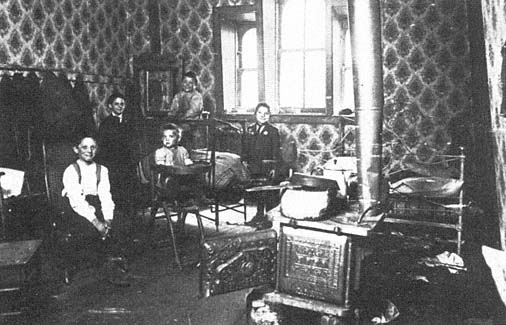
Figure 1.5
A hotel family of Eastern European immigrants in Chicago, 1910.
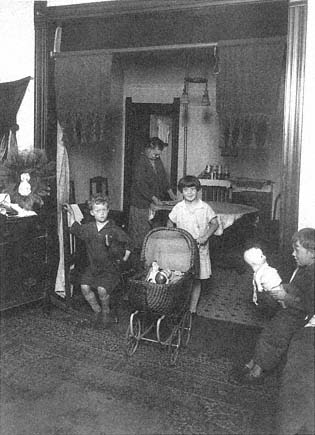
Figure 1.6
A hotel family of recent migrants to Chicago, 1929.
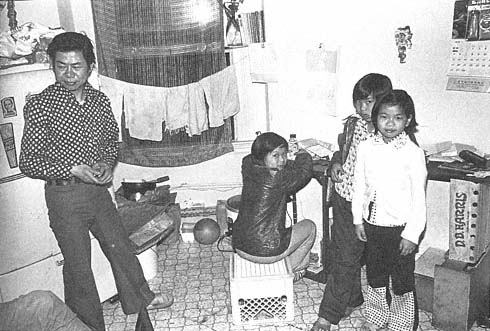
Figure 1.7
A hotel family of Southeast Asian immigrants in San Francisco, 1980.
for good reasons. The promoters propose (against loud clamors from the other side) that cities should be building more residential hotels.
Although the term "SRO" is relatively new, for at least one hundred years other commentators have railed against the real and implied dangers of single-room housing. In 1916, Walter Krumwilde, a Protestant minister, saw the rooming house or boardinghouse system "spreading its web like a spider, stretching out its arms like an octopus to catch the unwary soul."[33] Early social workers abhorred the idea of commercialized, retail housing for the poor. Generations of hotel critics have used photographs of families living in single rooms to shock Americans into recognition of SRO problems and to prompt ameliorative action. These different eras of hotel family portraits have a haunting similarity (figs. 1.5, 1.6, 1.7). Today many city health officials, architects, city planners, and politicians still argue that no one should live in hotels. Hotels, they say, exhibit severe social and physical maladjustment. Eliminating the hotel stock, the critics argue, will eliminate a public nuisance. One of the recurring complaints from people who are fighting for hotel residents is that no one seems to know very much about hotel people or the buildings they live in. This ignorance is not an accident.
Cultural Invisibility
Hotel residents and buildings are real enough, but they stubbornly remain outside of public awareness. Not surprisingly, two of the path-breaking books of the 1970s on SROs have the words "unseen" and "invisible" in their titles.[34] Early in the fight to make hotel life better understood, a St. Louis observer, Ira Ehrlich, summarized the problem in direct terms:
Single room occupants are omitted in the language of housing legislation, written off in the minds of communities, ignored and rejected in urban development plans, and pushed from one area to another on the waves of fluctuating real estate markets.[35]
More recently a San Francisco architect and scholar, John Liu, has written that "the Single Room Occupancy (SRO) residential hotel is perhaps the most controversial, the most neglected, and the least understood of all housing types."[36]
Hotel lives are culturally invisible in part because the public is disinterested and ignorant about any housing needs of the poor. Cushing Dolbeare, a founder and longtime executive director of the National Coalition for Low-Income Housing, complains, "As a problem, housing often eludes our grasp. It does not gain the political constituency it deserves. Other than homelessness, housing needs are simply not visible to most Americans."[37] Another barrier to understanding hotel life is based on the fact that so many hotel people are single and have developed social orders strongly differing from those in traditional American family units. Housing needs for single people—twenty-five years of age or fifty-five years of age—are rarely discussed even by housing experts. One of the path-breaking New York hotel activists, Carroll Kowal, writes that "federal housing policy deals with the population it is comfortable with: the family. Housing authorities have no understanding of non-family persons," let alone living units with no kitchens and a bath down the hall.[38] The numbers of single people tend to be underestimated throughout our society, even though they have always been an important share of the American adult population. In 1980, America had about 50 million married households and 21 million people living alone.[39]
Small hotels, which can make up half of a city's residential hotel stock, are easy to miss because the hotel rooms are usually on second and third floors above retail shops. Signs left from the 1920s feebly
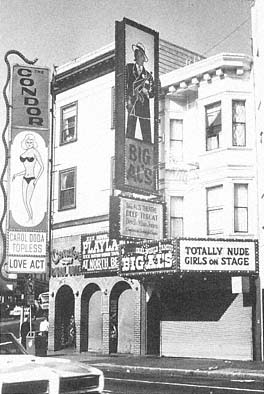
Figure 1.8
The corner of Broadway and Columbus Avenue
in San Francisco's North Beach neighborhood
in 1985. Between Big Al's and the Condor Club
is the small street entrance to the residential
hotel above Big Al's.

Figure 1.9
Isometric drawing of the Sierra House, the rooming
house above Big Al's North Beach nightclub.
announce the upstairs hotel functions while public attention is distracted by the signs and show windows of stores, restaurants, and nightclubs. In San Francisco's North Beach entertainment district, Carol Doda's sign and club at Broadway and Columbus were wellknown landmarks to tourists and residents (fig. 1.8). Yet within three hundred feet of that sign, on the second and third floors of the buildings, are over three hundred hotel homes (fig. 1.9).[40] Virtually no one passing on Broadway thinks about those seventy-year-old dwellings, or who lives in them.
More expensive hotel life is hard to see as well. Travelers in expensive hotels assume everyone else is a transient guest, too. Old buildings with names like the Barrington prompt the belief that they have always been apartment buildings when, in fact, they were originally hotels. At a public meeting in 1981, Melvin Carriere, a vice president in San Francisco's Wells Fargo Bank, confessed that he had never heard of a residential hotel or the notion of living in one until a community group asked for a hotel loan. He had been passing residential hotels every day
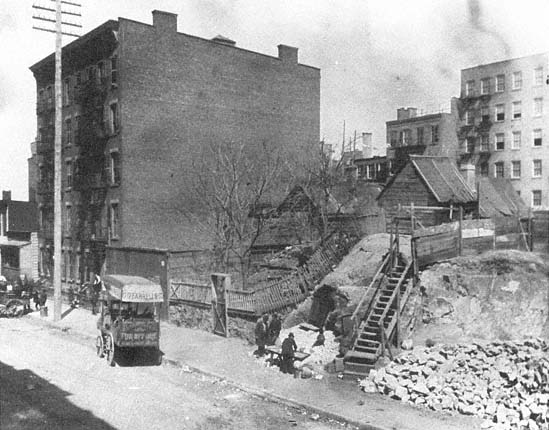
Figure 1.10
The unfinished city. Jacob Riis's photograph of small wooden shacks next to a brick tenement
in Hell's Kitchen in New York City emphasized the problems of old city rules.
on his way to work but had never noticed them. "I couldn't believe people wanted to live in a hotel," he added.[41]
Another barrier to understanding hotels is revealed when writers persist in labeling all people who live in hotels or motels as "homeless." The horrors of New York's welfare hotels or the squalor of a Los Angeles residential motel frequently matches the worst of homeless conditions. But if not overcrowded, a good hotel room of 150 square feet—dry space, perhaps with a bath or a room sink, cold and sometimes hot water, enough electric service to run a 60-watt bulb and a television, central heat, and access to telephones and other services—constitutes a living unit mechanically more luxuriant than those lived in by a third to a half of the population of the earth. As Dolores Hayden reminds us, many of the world's people would consider an American two-car garage an excellent dwelling in its own right.[42] The urban Americans living in hotels are not homeless. They are living in admittedly minimal and unusual dwelling units, often in hideous re-
pair and under woefully inadequate management but dwelling units nonetheless. Calling SRO people homeless reinvokes the cultural bias against hotel life. In the long run, the ecologically and culturally aberrant idea about housing may prove to be the huge single-family house on an open lot, not the more social way of living downtown in a hotel.
Other barriers to appreciating hotels have to do with the different notions people have about the ideal city. Supporters of hotels and those who see them as perverse ghettos hold deeply rooted and opposing conceptions about the proper rules for building urban space. The old city view stems from centuries-old European mercantile cities that had an urbane, densely congregated way of living with mixed income groups, adjacencies of housing, commerce, and workshops, all in buildings that crowded their lots and the street, with very little guarantee of permanence or a finished state (fig. 1.10). Downtown American hotel districts are a holdover of old city life.
After 1880, visionary experts and commercial leaders in America worked feverishly on building a new kind of city. Faced with the social and physical problems of industrialization in cities, directed by the needs and values of business elites, and reinforced by discoveries in public health, reformers consciously rejected the building and land-use rules of the old city. Beginning in large new suburbs, in vast industrial works, and in monumental architectural projects downtown, reformers and property developers embraced a modern set of architectural rules built around separation and specialization. The new rules promised each function in an area by itself, uniformity within areas, less mixture of social classes, maximum privacy for each family, much lower density for many activities, buildings set back from the street, and a permanently built order (fig. 1.11). By the 1890s, new city ideas had begun to be popular, particularly among the middle and upper class. Promoters of the new city planned for hotel living to be a deliberate casualty of the transition between the old city and the new city. Thus, as early as the 1890s, hotels had begun to be forbidden housing; their residents, forbidden citizens. These tensions between ideals were particularly clear in rapidly growing new cities.
San Francisco's Hotels as Exemplars
This study draws on a national literature but focuses especially on the hotel history of San Francisco. San Francisco rarely led national trends
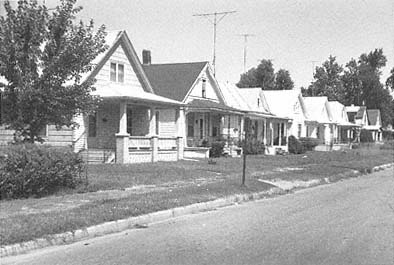
Figure 1.11
Workers' houses near the Santa Fe railroad yards, Topeka, Kansas,
built ca. 1915. New neighborhoods like these stressed the uniformity,
single use, and visually coherent organization of new city rules.
in hotel life; instead, its experience after the Civil War epitomizes experiences repeated, with minor variations, in hundreds of other American cities. What was ordinary in San Francisco proved similar to what was ordinary in Chicago, New York, or St. Louis. Thus, in the chapters that follow, examples from San Francisco will predominate with corroborating asides and illustrations drawn from elsewhere.
A Case Study City
Compared to cities on the East Coast, San Francisco's evolution began late and eccentrically with the gold rush of 1849. From 1849 to 1870, San Francisco was notoriously unlike other cities: it had many more men than women, more Chinese immigrants than anywhere else in the United States, a notoriously unconventional population, and very tenuous transportation links to the East. However, by 1870, San Francisco's manufacturing and downtown office employment was burgeoning; by 1880, its population profile looked roughly similar to that of other large U.S. cities. Some differences remained. Tourism was a greater part of the urban economy than in other American cities. The housing of San Francisco—wooden row houses instead of wooden open-lot houses—was also more like that of the East Coast or older midwestern cities than like other cities of the West or the South. But with those exceptions, San Francisco's industries and housing roughly reflected national patterns. By 1900, San Francisco ranked eighth in the nation for industrial production, and it was also
the predominant wholesaling and financial center for much of the West. The earthquake and fire of 1906 leveled all of downtown but merely hastened the rebuilding of obsolete structures. By 1915, the land uses and buildings of rebuilt San Francisco were not strikingly different from those in cities that had no great fire.[43]
More than was true in any other city, the citizens of San Francisco tested the validity of hotel living. Nineteenth-century tourists noted that "vast numbers" of residents lived in hotels and ate exclusively in restaurants. In both 1880 and 1900, the ratio of boardinghouse and rooming house keepers in proportion to the total population was higher in San Francisco (and other new West Coast cities) than in many of the older American cities.[44] Surely if hotel housing were to have bested its critics anywhere, it would have been in San Francisco. In the late 1950s, Alfred Hitchcock's Vertigo portrayed downtown hotels as natural homes for the city's young secretaries. In the 1970s, some of the most bitter struggles over hotel living—the destruction of hotels in the South of Market and the fight over the International Hotel—showed an unusual public awareness of hotel housing.
While more of a hotel city than other cities, San Francisco was not an anomaly. It was simply the most highly developed example of hotel housing. Because so much of the city's economy and population appeared after 1865 on a relatively empty stage, San Francisco's architectural and social history exhibited national post-Civil War industrialization and trade with little competition from previous eras. Bursts in hotel construction in San Francisco were also matched in other West Coast cities, in the Midwest, and on the East Coast.[45] Based on both written and architectural evidence, San Francisco had about 15,000 hotel rooms of all types in 1880, or about one hotel room for every 16 people in the population. In 1910, those figures had grown to 65,000 total rooms, or one hotel room for every 10 people (table 1, Appendix). That ratio remained roughly the same through 1980.[46]
From the early 1800s up to the 1960s, managers in hotels of all types mixed permanent and transient guests, often with seasonal variations. A 1930 survey of the more expensive American hotels showed that about a third were mainly transient and about a sixth were mainly permanent. Managers of the remainder called their businesses "mixed transient and permanent."[47] The mixture of transient and permanent guests also varied by the type of hotel. It appears that permanent resi-
dents lived in an average of 20 percent of the rooms in the most expensive third of American hotels and at least 75 percent of the rooms in the remaining cheaper hotels.[48] This was likely the case for at least several months of the year (if not year-round) and in most American cities. Applying these ratios to San Francisco indicates that a consistent 60 percent of all of the city's hotel rooms between 1880 and 1930 were permanent residences for at least one or two seasons of the year. This is slightly more than the precise 52 percent reported for San Francisco in 1980, with the city's much expanded tourist industry and reduced use of hotels as residences.[49] A San Francisco sample also revealed four very distinctly stratified sets of building types that are found in most American cities.
Hotel Ranks, Social Class, and the Plan of the Book
The four types of average hotels in San Francisco can be characterized as palace hotels, midpriced hotels, rooming houses, and cheap lodging houses. These four ranks of building types, arrived at strictly by architectural evidence, closely match social stratification suggested in written records. In 1903, for instance, the New York hotel keeper Simeon Ford amused a banquet of hotel managers with this characterization of hotel life:
We have fine hotels for fine people,
good hotels for good people,
plain hotels for plain people,
and some bum hotels for bums.[50]
The original construction details of these four types of hotels—especially their plumbing and air wells—were surprisingly reliable counterparts to the social stratification and class differences of their intended original clients as summarized by Ford. By the end of the nineteenth century, city residents easily recognized the four types of hotels and the social status of their residents (these are discussed in detail in chaps. 2–5).
At the social pinnacle were the buildings of a price range best called the palace hotel rank (fig. 1.12). Like Cyril Magnin, the people who lived in such hotels were generally from the nation's wealthiest families. When people at this rarified social and economic level chose their homes, cost mattered little. Their hotel suite was often one of several
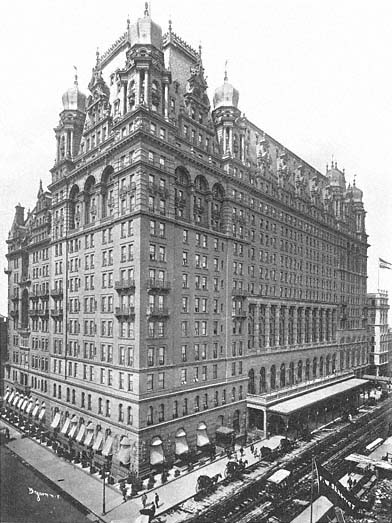
Figure 1.12
The original Waldorf-Astoria, a quintessential palace hotel. In 1907, it
became the largest hotel in the world when the Astoria section was added
to the 1893 Waldorf.
residences. If they lived in an apartment, it was also palatial; if they had a house, it could be a mansion or an estate.
Hotels of the next cheaper type, the midpriced hotel rank , were intended for overnight guests and permanent residents who had a comfortable income and intermediate social status (fig. 1.1). In their basic values, politics, museum or church activities, education, and recreation, these people often emulated the truly wealthy. With their best clothes and manners they could infiltrate the palace hotel dining room for a memorable meal, but they could not live like that every day. Their incomes forced compromise, but as chapter 3 shows, it was socially respectable compromise. If they had not lived in a hotel, they might
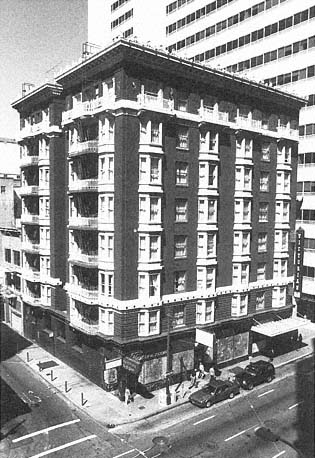
Figure 1.13
Typical midpriced hotel, built in 1914.
have chosen a substantial private house or flat with one to three servants or an apartment hotel.
Americans informally called these two social strata the upper class and the middle class. However, between these two groups there was little of the social or cultural opposition that theorists require for a true division between classes.[51] The palace and midpriced hotel groups were two levels within a single class; they were the "middle and upper class," with "class" in the singular. The material culture evidence of their hotel housing, like other social and cultural indicators, showed that their differences were matters of degree rather than proof of sharply divergent and opposing realms. For people in the middle and upper class, hotel life was a choice; they could afford to live in other ways and encountered few barriers in doing so. However, the people in the middle and upper class were in clear cultural and often political opposition to the
residents of the two less expensive hotel types, whose residents had much less choice in housing. In their work, ownership of property, and access to cultural and economic power, the people of the upper two hotel ranks differed markedly from those of the two lower hotel ranks. Here was a true class division with both cultural and economic formations. Their material culture was an important reinforcement—not merely a reflection—of position and power. Both sides displayed in their material life a decided class consciousness, as was particularly clear with rooming house residents.
Ford called the rooming house rank of hotels "plain hotels for plain people." Such places were home for people in skilled trades who earned a steady but relatively low income, especially before the 1930s. For the single teacher, stenographer, and machinist, their rooms, their financial instability, and often their personal lives were evidence of the sharp division that stood between them and the upper and middle class. However, chapter 4 shows that rooming house residents relied on their rooms for a minimum of material respectability, a tool to mask their differences from the middle and upper class. If roomers wished to live outside of a family or live alone, they had few other affordable housing choices. Roomers also had the choice of boarding or lodging with a family, with the consequence of again living under household surveillance.
Finally, at the cheap lodging house rank , hoboes and day laborers hung precariously on to shelter with the marginal incomes they obtained when work was available. While the cultural opposition of rooming house residents was subtle, lodging house residents lived and worked in flagrant opposition to the rules of the middle and upper class. The lodging house residents' poverty, backgrounds, political beliefs, family life, speech, and education all set them utterly apart from the polite society of the middle and upper class. If they wished to live in the city, lodging house residents had virtually no other choice but to live in some version of a cheap downtown hotel (fig. 1.14).
The cultural and social opposition of rooming houses and cheap lodging houses to middle and upper class norms did the most to bring official condemnation on hotel housing of all four ranks. The first half of this work analyzes hotel life and downtown cosmopolitanism as valuable public resources, while the second half traces the idea of hotel life as a public nuisance. Chapter 6 examines the segmentation of hotel
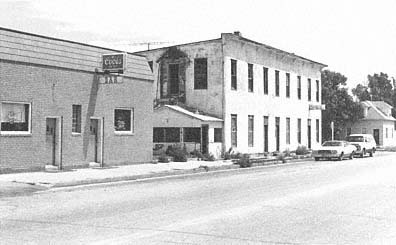
Figure 1.14
Workers' hotel in Mineral Wells, Colorado, 1985. Residential hotels
have been common in small towns as well as in large cities.
This small lodging house apparently closed about 1970.
owners and how their increasing specialization of the city intensified downtown as a zone of residential opposition. Chapter 7 looks in detail at the critiques of hotel life and the gradual ways that residential hotels became defined as an aberration. The last two chapters follow the expert reformers of the Progressive Era and the post-World War II period as they worked to build the long-desired new city and to eliminate hotels and cosmopolitan diversity. No matter what position one takes on hotels as homes, their rapidly dwindling inventory cannot be seen simply as an accident of supply and demand in a free market. The crisis in the residential hotel supply is a planned event—a function of local, state, and federal government policies that have encouraged housing for some types of people and reduced supplies of housing for others.[52]
The mistrust of cheaper hotels is more understandable in light of their historical dominance in downtown hotel life (fig. 1.15). The residential proportion of hotels was heavily weighted toward the inexpensive hotel types. Indeed, the architectural evidence in San Francisco reveals that cheap lodging-house rooms made up half of the city's hotel homes. Rooming houses provided a third of the residential hotel rooms. Rooms likely to be used as permanent residences in palace and midpriced hotels, combined, made up only the remaining sixth of the residential hotel stock. These proportions remained roughly the same between 1880 and 1930 (table 1, Appendix).[53]
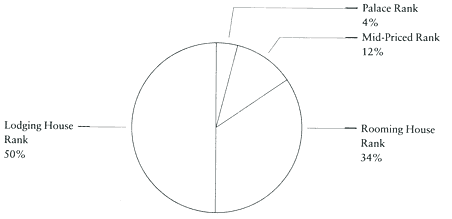
Figure 1.15
Proportional diagram of residential hotel rooms, by rank, in San Francisco in 1930.
Surveys in 1880 and 1910 revealed similar distributions.
The issues of hotel life still reverberate in the lives of recent hotel residents—from Cyril Magnin in his palace hotel and Dorothy Johnson in her midpriced hotel to people like Jane Wagner in rooming houses and the Filipino laborer Felix Ayson in his cheap lodging house. The history of hotel living shows the dangers of too rigidly enforcing a single ideal for the American home. Nonetheless, the people who felt most immune from the criticism of hotels were those in palace hotels. More than any other types of hotel residents, they had all the advantages of living downtown.